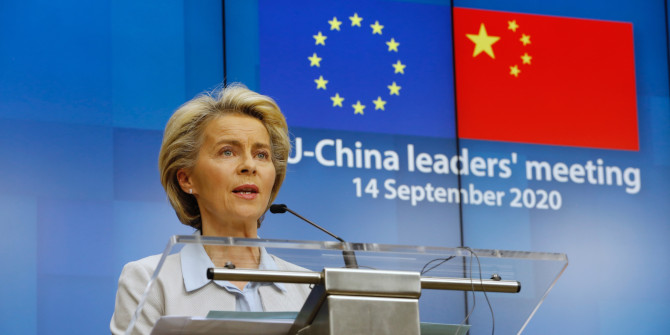At the end of last year, China and the EU reached agreement on a new investment deal, the Comprehensive Agreement on Investment (CAI). Robert Basedow examines the content of the agreement and assesses what lessons the UK can draw from the negotiations as it seeks to establish its own post-Brexit relationship with China.
In late December, the European Commission and Chinese government announced they had reached an agreement in principle on the so-called Comprehensive Agreement on Investment (CAI). This news drew considerable attention not only among European and Chinese observers but also in the United States and UK. Many commentators expect significant economic gains from the CAI, while others see it as a geopolitical coup and a message from Brussels and Beijing to post-Trump Washington. Are these hopes (or fears) justified? What are the economic and political implications of the CAI? And what does it mean for the UK?
Putting the agreement in perspective
First of all, it is important to address a widely held misconception. The CAI is no free trade agreement (FTA). It is an international investment agreement that stands in the tradition of bilateral investment treaties (BITs). BITs are fundamentally different from FTAs. FTAs seek to liberalise international trade – in its various forms – through tariff reductions, market access commitments and manifold trade-related regulatory provisions. BITs, on the other hand, seek to regulate how host states treat established foreign investors and to prevent uncompensated, discriminatory expropriation.
Further, they often provide for the enforcement of treatment and protection standards through the (in)famous investor-to-state dispute settlement (ISDS) approach that enables foreign investors to sidestep allegedly biased legal systems and courts in host countries. Last, very few modern investment agreements furthermore encompass investment liberalisation commitments. Whereas economic studies suggest that modern FTAs boost economic integration among contracting states, BITs tend to have ambiguous economic effects.

Credit: European Council
How then does the CAI compare to existing international investment agreements? First, it does not contain traditional language on post-establishment treatment and protection standards such as ‘full protection and security’ or ‘fair and equitable treatment’ clauses. Instead, it seeks to create a level playing field for European investors after their establishment through provisions that prohibit forced technology transfers, increase transparency on subsidies, state-owned enterprises and administrative procedures.
Second, the CAI does not contain ISDS provisions that allow investors to seek compensation if the EU or China breach the above commitments. It only provides for state-to-state arbitration if the EU and China disagree over the interpretation and application of the agreement. Third, the CAI encompasses a schedule of manufacturing and services sectors open to foreign investments. Fourth, it contains ‘best effort’ language on sustainable development including the ratification of conventions of the International Labour Organisation on forced labour and implementation of the Paris Agreement. In sum, the CAI is an investment agreement but an unusual one that differs in important regards from classic BITs.
What are the likely economic implications of the CAI?
The provisions on the level playing field are certainly a step forward from the perspective of European investors in that they promise to address important grievances of European firms active in China. Two caveats apply though. Foreign firms often complain about informal discrimination from provincial or local governments rather than the central government, which has repeatedly sought to curtail such practices. It is unclear to what extent local and provincial governments will respect the CAI.
Furthermore, relevant provisions are largely toothless from the perspective of European investors due to the lack of ISDS or the EU’s new Investment Court System in the CAI. Investors cannot directly invoke these provisions to trigger arbitration and seek compensation but must lobby policy-makers to take up their grievances under state-to-state dispute settlement. That being said, European investors anyway indicated during the negotiating process that they would refrain from using ISDS against China due to fears over retaliation.
In conjunction with the EU’s legal and political struggles to negotiate and ratify treaties with ISDS, it thus does not surprise that the CAI merely contains a commitment from the EU and China to continue talks to put into place a fully-fledged investment protection and dispute settlement framework in the next two years. Until then, old member state BITs with China – for better or for worse – will continue to provide for varying levels of investment protection and access to old-fashioned ISDS.
The CAI, furthermore, received a lot of attention due to its investment liberalisation schedule and promise to unlock new business opportunities for European firms in China. In the very beginning of the talks a decade ago, China sought a fully-fledged FTA with the EU. The EU, however, was unwilling to put an FTA on the table in view of its growing trade deficit vis-à-vis China and instead pushed for an investment agreement with liberalisation commitments to rebalance the economic relationship and unlock notably Chinese service sectors for European investors.
It is too early to cast a judgement on the economic value of the investment liberalisation commitments, but it seems that the CAI mostly locks in existing levels of investment liberalisation both in the EU and China. In other words, the CAI commits both sides to keep their economy open even in times of crisis yet does not offer many new investment opportunities. This is not unusual for this type of agreement. It nonetheless implies that the economic gains from the CAI may be humbler than is often assumed in the public debate.
It is also noteworthy in this context that the EU adopted its new FDI screening mechanism to condition or block foreign investments in sensitive and strategic sectors and published a new white paper on how to tackle competitive distortions in the single market tied to foreign subsidies during the last negotiating rounds of the CAI. The EU is thus sending a mixed message to Beijing by committing to open investment relations but equally putting into place policy instruments to curb and regulate Chinese investments if need be.
These observations suggest that the CAI has predominantly political implications. To start with, the EU is seeking to establish new economic ground rules and a bilateral platform to discuss economic and political concerns with China. It is an instrument to promote dialogue. Further, the EU is aiming to draw even with the so-called ‘Phase One Deal’ that the Trump administration struck with Beijing which indeed tackles similar items.
The timing of the agreement in principle on the CAI, moreover, suggests that the EU wants to put pressure on the new Biden administration. The message is that the EU and China are willing to cooperate in global economic governance and that the United States should better return in good faith to the negotiating table – notably in the WTO – to modernise global economic regimes. The appeal of the CAI for Beijing is most likely also rooted in this very message. It demonstrates that China is not isolated and major OECD economies are willing to engage with it. What is more, Beijing is quite likely seeking to use the CAI domestically to lock in ongoing economic reforms strengthening markets.
What lessons can the UK draw from the CAI?
The EU, with its important bargaining power rooted in its single market, arguably still failed to unlock the riches of the Chinese economy and notably service markets for European investors. Indeed, the EU has had to phase in new instruments to potentially restrict Chinese market access to arrive at this deal. The UK as an open and much smaller economy than the EU or US is thus unlikely to attain better results in terms of market access to Chinese service markets.
The CAI, in other words, quite likely constitutes the upper bound of what the UK can reasonably expect to get from Beijing in future negotiations. The best chance that the UK stands in terms of increasing its leverage is to conclude an ambitious comprehensive FTA on services trade with the EU in the coming years so as to position itself vis-à-vis China (and others) again as an entry door to the EU’s single market.
Another important lesson for the UK may arise from the ratification of the CAI. The EU and China only agreed in principle. It remains to be seen whether the European Parliament will actually ratify the treaty, if reports about Human Rights abuses against the Uighur minority and a clampdown on democracy in Hong Kong continue. The recent adoption of EU sanctions against Chinese officials allegedly involved and immediate Chinese countersanctions against Members of the European Parliament raises questions over the future of the CAI. Very similar debates are likely to play out in the UK. In sum, the CAI may come with limited economic benefits and its value is likely to be mostly political. Yet whether these benefits can be achieved remains uncertain given the potential ratification hurdles.
Note: This article gives the views of the author, not the position of EUROPP – European Politics and Policy or the London School of Economics. Featured image credit: European Council





